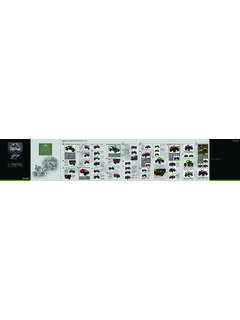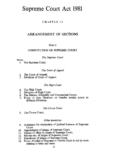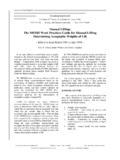Transcription of First Report of AIDS
1 First Report of AIDST wenty years ago, on June 5, 1981 , MMWR published a Report of five cases ofPneumocystis carinii pneumonia (PCP) among previously healthy young men in LosAngeles (1). All of the men were described as homosexuals ; two had died. Localclinicians and the Epidemic Intelligence Service (EIS) Officer stationed at the LosAngeles County Department of Public Health, prepared the Report and submitted itfor MMWR publication in early May 1981 . Before publication, MMWR editorial staffsent the submission to CDC experts in parasitic and sexually transmitted editorial note that accompanied the published Report stated that the case histo-ries suggested a cellular-immune dysfunction related to a common exposure anda disease acquired through sexual contact. The Report prompted additional casereports from New York City, San Francisco, and other cities. At about the same time,CDC s investigation drug unit, the sole distributor of pentamidine, the therapy for PCP,began to receive requests for the drug from physicians also to treat young men.
2 InJune 1981 , CDC developed an investigative team to identify risk factors and todevelop a case definition for national surveillance. Within 18 months, epidemiolo-gists conducted studies and prepared MMWR reports that identified all of the majorrisks factors for acquired immnodeficiency syndrome ( aids ). In March 1983, CDCissued recommendations for prevention of sexual, drug-related, and occupationaltransmission based on these early epidemiologic studies and before the cause of thenew, unexplained illness was has published more than 400 reports about human immunodeficiencyvirus (HIV) and aids and remains a primary source of information about the epide-miology, surveillance, prevention, care, and treatment of HIV and aids . This anniver-sary issue provides new reports on the epidemiologic features and impact of HIV/ aids on communities in the United States and in other countries.
3 A compilation ofnotable MMWR reports on HIV and aids is available at A video that includes interviews with participants in these First aids investigations and reports and a video summary of each Report in this issue is avail-able at CDC. Pneumocystis pneumonia Los Angeles. MMWR 1981 ;30:250 1, 2001 / Vol. 50 / No. DEPARTMENT OF HEALTH & HUMAN SERVICES 429 First Report of aids 430 HIV/ aids United States, 1981 2000 434 The Global HIV/ aids Epidemic,2001 440 HIV Incidence Among Young MenWho Have Sex With Men Seven Cities, 1994 2000 444 Notice to Readers430 MMWRJune 1, 2001 HIV and aids United States, 1981 2000 The acquired immunodeficiency syndrome ( aids ) epidemic has had a substantialimpact on the health and economy of many nations (1). Since the First aids cases werereported in the United States in June 1981 , the number of cases and deaths amongpersons with aids increased rapidly during the 1980s followed by substantial declines innew cases and deaths in the late 1990s.
4 This Report describes the changes in the charac-teristics of persons with aids since 1981 . The greatest impact of the epidemic is amongmen who have sex with men (MSM) and among racial/ethnic minorities, with increases inthe number of cases among women and of cases attributed to heterosexual transmis-sion. The number of persons living with aids has increased as deaths have the epidemic requires sustained prevention programs in all of these affectedcommunities, particularly programs targeting MSM, women, and injection drug analyzed reported aids cases from 1981 through 2000 from the 50 states,District of Columbia, and territories. Proportions by sex, age, race/ethnicity, region,and vital status (living or deceased) were computed over four time periods correspond-ing to changes in the aids case definition and the introduction of effective combinationantiretroviral therapy (Table 1).
5 Trends in estimated aids diagnoses and deaths of per-sons with aids were adjusted for reporting delays based on the number of casesreported to CDC through June 2000, and for anticipated reclassification of cases origi-nally reported without human immunodeficiency virus (HIV) infection risk aids prevalence was calculated as the cumulative incidence of aids minuscumulative deaths adjusted for reporting delays (2).As of December 31, 2000, 774,467 persons had been reported with aids in theUnited States; 448,060 of these had died; 3542 persons had unknown vital status. Thenumber of persons living with aids (322,865) is the highest ever reported. Of these, 79%were men, 61% were black or Hispanic, and 41% were infected through male-to-malesex. Of the aids cases, approximately one third were reported during 1981 1992, 1993 1995, and 1996 2000 (Table 1). aids incidence increased rapidly through the 1980s, peaked in the early 1990s, andthen declined (Figure 1).
6 The peak of new diagnoses was associated with the expansionof the aids surveillance case definition in 1993 (2). As of 1996, sharp declines werereported in aids incidence and deaths. From 1998 through June 2000, aids incidenceand deaths leveled off and aids prevalence continued to increase. Throughout the epi-demic, approximately 85% of persons diagnosed with aids were aged 20 49 years(Table 1).In the early 1980s, most aids cases occurred among whites. However, cases amongblacks increased steadily and by 1996, more cases occurred among blacks than anyother racial/ethnic population. Cases among Hispanics, Asians/Pacific Islanders, andAmerican Indians/Alaska Natives have increased also (Table 1).Male-to-male sex has been the most common mode of exposure among personsreported with aids (46%), followed by injection drug use (25%) and heterosexual con-tact (11%).
7 The incidence of aids increased rapidly in all three of these risk categoriesthrough the mid-1990s; however, since 1996, declines in new aids cases have beenhigher among MSM and injection drug users than among persons exposed throughheterosexual contact (Figure 2).Vol. 50 / No. 21 MMWR431 HIV and aids in the United States ContinuedTABLE 1. Number and percentage of persons with aids , by selected characteris-tics and period of Report United States, 1981 20001981 19871988 19921993 19951996 2000 CharacteristicNo.(%) No.(%) No.(%) No.(%)SexMale46,251( )177,132( )211,909( )204,730( )Female 4,029( )25,387( )45,353( )59,672( )Age group (yrs)0 4649( )2,763( )2,105( )1,355( )5 12101( )667( )650( )618( )13 19199( )759( )1,381( )1,722( )20 2910,523( )38,507( )43,445( )36,252( )30 3923,239( )92,178( )116,335( )114,072( )40 4910,472( )46,922( )67,475( )78,032( )50 593,684( )14,494( )19,153( )23,980( )>601,413( )6,230( )6,718( )8,373( )Race/EthnicityWhite,non-Hispanic30,033( )102,130( )109,101( )88,896( )Black,non-Hispanic12,796( )63,319( )97,742( )118,665( )Hispanic*7,044( )35,116( )47,442( )52,092( )Asian/PacificIslander312( )1,342( )1,927( )2,147( )American Indian/Alaska Native68( )437( )870( )962( )Region Northeast19,541( )62,102( )78,000( )81,466( )North Central3,772( )20,416( )25,778( )25,532( )South12,933( )65,754( )89,559( )102,576( )West13,502( )46,303( )55,586( )45,574( ) territories524( )
8 7,883( )8,812( )8,829( )Vital statusLiving2,103( )20,572( )96,998( )203,192( )Deceased47,993( )181,212( )159,048( )59,807( )Total 50,280( )202,520( )257,262( )264,405( )* Persons of Hispanic origin may be of any race. Northeast=Connecticut, Maine, Massachusetts, New Hampshire, New Jersey, New York,Pennsylvania, Rhode Island, and Vermont; North Central=Illinois, Indiana, Iowa, Kansas,Michigan, Minnesota, Missouri, Nebraska, North Dakota, Ohio, South Dakota, and Wiscon-sin; South=Alabama, Arkansas, Delaware, District of Columbia, Florida, Georgia, Kentucky,Louisiana, Maryland, Mississippi, North Carolina, Oklahoma, South Carolina, Tennessee,Texas, Virginia, and West Virginia; West=Alaska, Arizona, California, Colorado, Hawaii, Idaho,Montana, Nevada, New Mexico, Oregon, Utah, Washington, and Wyoming. Includes persons for whom sex, age, race/ethnicity, region, or vital status are 1, 2001 HIV and aids in the United States ContinuedFIGURE 2.
9 Number of aids cases among men who have sex with men (MSM), injectiondrug users (IDU), and persons exposed through heterosexual contact, by quarter-yearof diagnosis United States, 1981 2000 FIGURE 1. Estimated aids incidence*, deaths, and prevalence, by quarter-year ofdiagnosis/death United States, 1981 2000* Adjusted for reporting DefinitionImplementationQuarter Year Quarter YearMSMIDUH eterosexual Contact1993 DefinitionImplementationVol. 50 / No. 21 MMWR433 HIV and aids in the United States ContinuedNearly all transmission of HIV through transfusion of blood or blood productsoccurred before screening of the blood supply for HIV antibody was initiated in 1985 (3).The number of persons reported with aids who were exposed through blood transfu-sions was 284 in 2000, down from a peak of 1098 in 1993. The number of perinatallyacquired aids cases peaked in 1992 (901 cases), followed by a sharp decline throughDecember 1999.
10 In 1999, 144 cases of perinatally acquired aids were by: Surveillance Br, Div of HIV/ aids Prevention, National Center for HIV, STD, and TBPrevention, Note: aids in the United States remains primarily an epidemic affecting MSMand racial/ethnic minorities. A new generation of MSM has replaced those who benefittedfrom early prevention strategies, and minority MSM have emerged as the populationmost affected by HIV. Socioeconomic factors ( , homophobia, high rates of povertyand unemployment, and lack of access to health care) are associated with high rates ofHIV risk behaviors among minority MSM and are barriers to accessing HIV testing,diagnosis, and treatment (4). Minority MSM may not identify themselves as homosexualor bisexual because of the stigma attached to these activities and may be difficult toreach with HIV prevention messages. In addition, the proportion of aids cases attributedto heterosexual contact and among women is substantially greater than earlier in public health successes have been achieved during the aids systems were established following the First reports in 1981 (5).
















